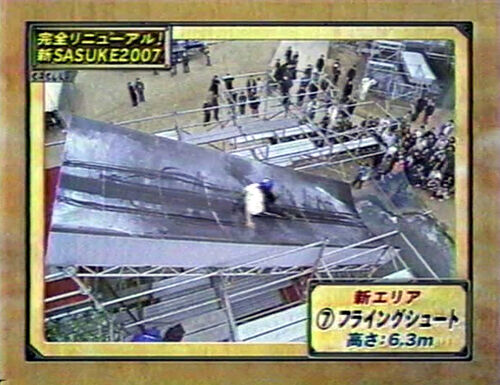| Line 40: | Line 40: | ||
|align="center" style="background-color: #DDDDDD;"|[[SASUKE 20|20]] |
|align="center" style="background-color: #DDDDDD;"|[[SASUKE 20|20]] |
||
|align="center" style="background-color: #DDDDDD;"|9 |
|align="center" style="background-color: #DDDDDD;"|9 |
||
| − | |align="center" style="background-color: #DDDDDD;"| |
+ | |align="center" style="background-color: #DDDDDD;"|13 |
| − | |align="center" style="background-color: #DDDDDD;"| |
+ | |align="center" style="background-color: #DDDDDD;"|69.23% |
|- |
|- |
||
|align="center" style="background-color: #EEEEEE;"|[[SASUKE 21|21]] |
|align="center" style="background-color: #EEEEEE;"|[[SASUKE 21|21]] |
||
Revision as of 15:54, 10 December 2009
The Flying Chute (フライングシュート) is an obstacle introduced with the course redesign after Nagano Makoto's kanzenseiha in SASUKE 17. The objective of the Flying Chute is to slide down a 6.3m slide, grab onto a rope placed a certain distance away from the slide, and use momentum to reach a net placed underneath the slide. This obstacle has proven to be one of the most dangerous and hardest obstacles in the Shin-SASUKE First Stage, and has eliminated (or at least slowed down) every SASUKE All-Star except Yamada Katsumi (who has only attempted the obstacle once). The obstacle has been changed multiple times in the four tournaments that it was in the First Stage, throwing off competitors each time.
SASUKE 18 Version
The first version of this obstacle was rather basic. Competitors would slide down the chute, catch the rope underneath the arms, and reach for the net underneath the chute. This version required none of the timing, speed, or strategy required in future versions. Because of this, not many people failed here.

A tester demonstrating the Flying Chute.

Suzuki Naohiro attempting the Flying Chute in SASUKE 18.
SASUKE 19 Version
By far the hardest version of the Flying Chute. To make the obstacle harder for the competitors, the producers raised the rope and put it farther from the chute. In order to pass this obstacle, competitors needed great speed in order to gain enough momentum to reach the net and great timing. Jump too early and they would slide down the net and lose balance. Jump too late and competitors wouldn't be able to hold onto the rope and fall into the water (as Nagasaki Takamasa and Nagano Makoto did). On top of that, competitors also needed to only hold the rope with their bare hand, otherwise they would not be able to reach the net. Because of the great speed required to gain momentum, many competitors tried to reach the net on the first rebound, however, this proved fatal. This version of the obstacle was so hard, that only four people cleared successfully.

Yamada Koji attempting the redesigned Flying Chute in SASUKE 19.
SASUKE 20/21 Version
Because of SASUKE 19's extreme difficulty, the producers toned down the Flying Chute in order to make it a little easier for the competitors to pass. To do this, they moved the rope vertically down so it was same height as the SASUKE 18 version but also the same distance away from the net as the SASUKE 19 version. While more people did beat the obstacle, this version required more strategy than its predecessors. Competitors could go fast, try to endure the whiplash, and make it to the net on the first rebound, or competitors could go slow and try to land on the rope with enough force to get the necessary momentum to reach the net. This design also created several interesting and unique wipeouts, as some competitors flipped over the rope. It has since been taken out of the First Stage and was replaced in SASUKE 22 with the Slider Jump.

Okuyama Yoshiyuki attempting the redesigned Flying Chute in SASUKE 20.
Competitors' Success Rate
- All results based on the TBS broadcast and external information found
| SASUKE | Clears | Attempts | Percentage |
|---|---|---|---|
| 18 | 9 | 14 | 64.29% |
| 19 | 4 | 13 | 30.77% |
| 20 | 9 | 13 | 69.23% |
| 21 | 11 | 22 | 50% |
| Total | 33 | 52 | 63.46% |
